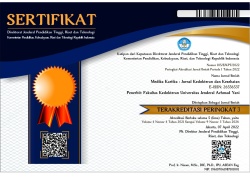AUTHOR GUIDELINE
GENERAL INSTRUCTIONS
Medika Kartika: Journal of Medicine and Health is published periodically quarterly a year (March, June, September, and December). Medika Kartika accepts research articles, case reports, literature reviews, and other relevant topics in medicine and health.
Research articles contain research findings in the field of medical and health sciences. The text format structure with the following sections: Title, Abstract, Introduction, Materials and Methods, Results and Discussion, Conclusion, Conflict of Interest, Acknowledgments, and References.
Literature reviews involve the review of articles on current topics in the field of medicine and health. The writing format for literature reviews consists of a Title, Abstract, Introduction, Content Section (Consisting of Subtitles), Discussion, Conclusion, Conflict of Interest, Acknowledgments, and References.
Case reports: Peers need to publish articles on exciting clinic cases included in case reports. The writing format for case reports consists of a Title, Abstract, Introduction, Content Section (Consisting of Case and Case Management), Discussion, Conclusion, Conflict of Interest, Acknowledgments, and References.
Submitted manuscripts should not have been previously published or are currently under consideration for publication in other journals, magazines, or publications. A statement indicating the presentation of research findings can lead to accepting their abstracts published in abstract books and presented at seminars. The content of the submitted article must have been read and approved by all authors listed in the paper through a Scientific Article Publication Agreement.
Experts in the relevant scientific field (peer-review system) will review the manuscript. Requiring revisions will be returned to the authors for improvement. Researchers must obtain approval from the ethics committee or consider ethical aspects when publishing research manuscripts. Published manuscripts result from a selection process approved by the Editorial Board.
MANUSCRIPT WRITING
The complete manuscript should follow the guidelines in the "Uniform Requirements for Manuscripts Submitted to Biomedical Journals," also known as "The Vancouver style," fourth edition published in BMJ 1991; 302: 338-41. Manuscripts in Indonesian should adhere to the General Spelling Guidelines of the Indonesian Language (PUEBI), guidelines for term formation, and terminology dictionaries. Medical terms in Indonesian should follow the "Development of the Indonesian Language in the Medical World" published in "MKI 2002; 52: 75-82."
Please submit manuscripts in Word format (.doc). The manuscript should be typed in Indonesian on A4-sized paper (21 x 29.7 cm), using Times New Roman font size 12, 1.5 line spacing, with a left margin of 3 cm, top margin of 3 cm, right margin of 2 cm, bottom margin of 2 cm, and the length of the manuscript should be no less than ten pages and no more than twelve pages. Each page should be numbered sequentially from the title to the last.
TITLE
The title page should include the title of the paper, author names, author affiliations, and the name and email address for correspondence. The title should consist of both Indonesian and English (written in capital letters) and be concise and clear. The number of words in the title should be 12-15, including keywords. The title should not contain abbreviations, formulas, or jargon. Avoid using words like "influence," "study," "some," or "observations on" in the title. Additionally, refrain from using metaphors, poetry, or proverbs.
AUTHOR INFORMATION
Agree upon the sequence of author names. Write the authors' names below the title without titles. The authors are fully responsible for the content of the manuscript. Designate the corresponding author's name (underline). The affiliation and email of the corresponding author are written below the authors' names. The affiliation should be complete (Department/Lab, Faculty, University, City, Province, Country).
ABSTRACT
The author should write the abstract concisely and clearly in Indonesian and English. The abstract is written in a single paragraph with a maximum of 250 words. A research article's abstract includes the study's background and objectives, research methods (including statistics), research results, and discussion and conclusions (IMRAD).
The author should write the abstract in a summary form for other manuscripts. There should be no references to tables, illustrations, or citations. The author must explain abbreviations. Below the abstract, separated by a space, should be 3-5 keywords in alphabetical order and lowercase.
INTRODUCTION
The introduction briefly describes the reasons for conducting the research or writing (research or writing background). The introduction includes the research objectives and the current scientific status. Include the hypothesis, if any. The introduction should consist of a maximum of 2-3 paragraphs.
MATERIALS AND METHODS
The materials and methods section provides a brief description of the research subjects, the place and time of the study, examination materials, research procedures, examination methods, and statistical methods used, as well as ethical approval for preclinical and clinical trials, including the number of ethical approval/recommendation letters, and attach the recommendation letter in the appendix. The researcher should describe the materials and methods in detail so that others can replicate the experiment.If the method refers to a standard procedure, write down the standard.
RESULTS AND DISCUSSION
The results are presented systematically according to the research objectives/hypotheses. The researcher presents the results in a narrative form, accompanied by tables and illustrations.
The narrative should only repeat all the contents of the tables and illustrations but should emphasize essential points or those that require discussion. Units and abbreviations should use the International System of Units (SI). All unusual terms, abbreviations, and symbols should be explained immediately after them in parentheses. The discussion focuses on the essential and new aspects of the research without repeating in detail the content already written in the introduction. When discussing each element, the researchers should connect their conclusions to relevant other studies.
The discussion should include logical arguments for interpretation implications and research limitations. In this case, the emphasis should be on new aspects (up-to-date, references less than ten years old).
FIGURES AND TABLES
Figures in this manuscript can be images, graphs, diagrams, or schemes. Figures are placed in the center of the page and spaced one line apart from the text above. The figure caption is placed below the figure and can consist of one or more sentences typed in single spacing. The figure caption begins with a capital letter at the beginning of the sentence and ends with a period. If the figure includes symbols, provide explanations for the symbols. The size of the symbols and their explanations must be proportional to the size of the figure and readable. Each figure in the text must be referred to at least once, for example, "...nucleic acid metabolism (Figure 1)." The figure caption should be clear, including the figure number, title, and brief explanation that can be understood independently from the text. Include the source below the figure caption if the figure is a quotation. Figures should be in jpg, tif, ppt, or gif format. Photo files should be submitted together with the text file—maximum of 6 images.
Place the title of the table above the table with a 1-space indentation. Start the table's title with a capital letter at the beginning of the sentence without a period at the end. If there are symbols in the table, explain them below the table. Reference each table in the text.
Footnotes in the table are non-numeric symbols such as *, †, and ‡ as footnotes indicators placed in the table where additional information is needed. Each table in the literature review should be referenced in the text at the bottom left of the table (Adapted from Author, Year).
When creating table lines, only horizontal bars are made for the outer border; no vertical lines are made for the inner horizontal lines. The table font type is Times New Roman 11, with a 1-space indentation—maximum of 6 tables.
CONCLUSION
According to the research or writing objectives, one paragraph presents the conclusion. If deemed necessary, the paragraph can include recommendations related to the research or writing.
CONFLICT OF INTEREST
The author states no conflict of interest in the written scientific articles.
ACKNOWLEDGMENTS
Acknowledgements are expressed to professionals who have assisted in the research and preparation of the paper, funding providers, materials and research facilities, and related sponsors.
REFERENCES
The references must be relevant, up-to-date, and from primary sources, using Mendeley's citation and reference management software. A minimum of 20 references is required, preferably at most the last ten years, with 80% from primary sources (journals). The writing of references follows the "Vancouver style" with the inclusion of numbers according to the "order of appearance" in the text. The writing of bibliographic sources uses superscript numbers after the period without spacing, according to the reference order (example: ... in developing countries.1,2,3).
Avoid using abstracts as references. For material submitted for publication but still needs to be published, refer to it as unpublished observations. Use the phrase "in the press" in the references for papers accepted for publication but not yet published.
Bibliography Format:
- Paper: Author's name, title of the paper, journal/magazine/proceeding, year, volume, pages.
- Textbook:
For individual authors: Author's name, title of the book, edition, city of publication, publisher's name, year.
For editors: Author's name, title of the chapter/subchapter, In: editor's name, edition, city of publication, publisher's name, year, pages.
For organizations as authors and publishers: Organization's name, title of the article, book/journal name, year, pages.
- Article: Author's name, title of the article, journal name, year, volume, issue (in parentheses), pages.
- Dissertation/Thesis: Author's name, title of the dissertation/thesis, [Dissertation/Tesis/Skripsi] (in brackets), city, university name, year.
- Electronic Materials: Author's name, title, website, [update date], [cited date], available from [URL].
Example
- Soemantri S. Masalah penyakit tuberkulosis di Indonesia dan Disampaikan pada Hari Tuberkulosis Sedunia tanggal 24 Maret 1999. RSUP Dr. Hasan Sadikin Bandung. 1999.
- Paterson PY. Infection in the compromised host. In: Youmans GP,Paterson PY, Herbert M, Eds. The Biologic and clinical basis of infectiousm 3rd ed. Philadelpia LondonToronto: W.B. Saunders Company, 1985:502-9.
- WHO-ISH (International Society Hypertension). Guidelines for the management of hypertension. JHypert,1999;11:905-18
- British Thoracic Society. Pulmonary Thorax, 2001:834-42.
- Jacobs DS, DeMott WR, Finley PR,Kasten BL, Tilzer LL, Trema PR, et al. Laboratory test handbook. 3rd ed. Hudson: Lexi-Comp Inc, 1994.
- Chang CL, Lee EY, Son HC, Park SK.Evaluating the usefulness of the ICT tuberculosis test kit for the diagnosis of J Clin Pathol, 2000; 53:10-7.
- Hood VL, Tannen RL. Protection of acid base balance by pH regulation of acid N Eng J Med, 1998;339(12):819-26
- Pinteric L. Tomato pest management University of California[update 2 Nov 2015; cited 17 Nov 2018].Available from http://www.ipm.ucdavis.edu/PMG/select pest.tomatoes.html.)
The guidelines for writing articles in Medika Kartika: Journal of Medicine and Health consist of 3 instructions: Research, Case Reports, and Literature Reviews. More details can be found in the following link.



























